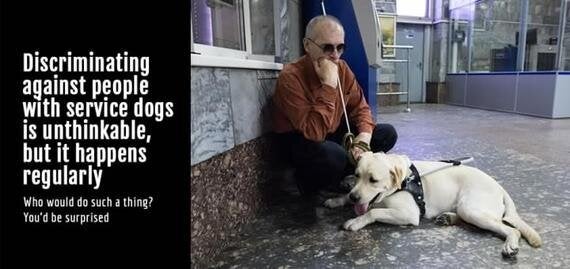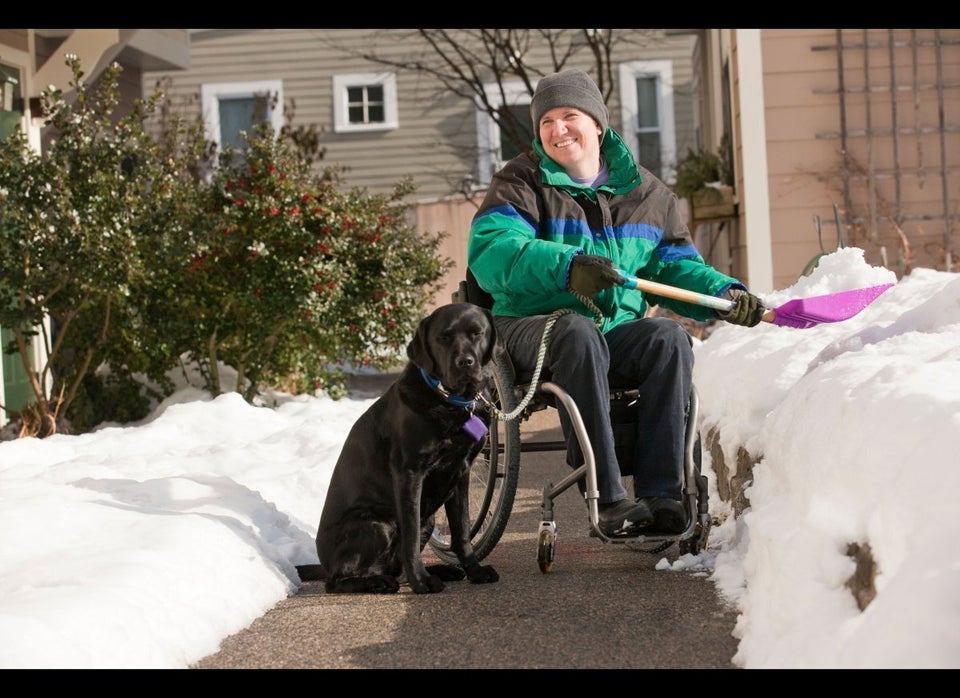
By Fransi Weinstein
Google it. You'll be horrified. I certainly was. Still am for that matter.
We're talking about veterans who risk their lives fighting for their countries and who return home with post-traumatic stress disorder (PTSD), or people who experience seizures, have diabetes, psychiatric issues, all manner of disabilities visible and invisible, and yes, people who are blind.
All of them, each and every one, are individuals who depend on service dogs to guide them, lead them, comfort them, protect them, alert them, watch over them and see for them. And every day, every hour, in cities and towns throughout North America, they are refused entry to stores, restaurants, cafes, hotels, taxis, airplanes and apartment buildings. Discriminated against.
They're told, "Your dog can't come in here. You're OK, but not your dog." Despite the fact that service dogs wear special harnesses to distinguish them. Despite the fact that most, if not all, of these people carry cards confirming that they have a disability. Despite the fact that it's against the law.
Clearly no one cares about breaking the law, mostly because the laws aren't enforced, or at least not often enough. And even then, as the one denied entry you have to prove the law was broken. Most often, you're alone, with no witnesses to come to your aid or defence. A he-said/she-said type of situation.
Reading about it is bad enough, but then I spoke with someone who has to deal with the discrimination first-hand.
Reeling from everything I was reading online, I wanted to talk to someone with a service dog to find out if the situation is really as bad as it seems. I wanted to find out if discrimination really is that prevalent, that widespread. I spent close to an hour on the phone with Diane Bergeron. What an eye-opener that was.
Diane is the executive director of strategic relations and engagement for the Canadian National Institute for the Blind (CNIB). She has a service dog, a gorgeous golden retriever named Lucy. She's always on the go in Ottawa, where she lives and works, and travelling on business, domestically and internationally.
Born with retinitis pigmentosa, she became legally blind at 10 and lost all sight at 30. Not one to let this or anything else stand in her way, she thrives on personal challenges, like skydiving, stock car racing and participating in the Ironman triathlon.
But the challenges of constantly having to defend her right to bring Lucy everywhere she goes is too much, even for this accomplished, independent and fearless woman. "Anything relating to food, hospitality and transportation is the worst," she told me.
Some of the issues Diane, and others like her, face all the time
"Even when I call for a taxi and tell them I'm blind with a service dog, cabbies very often drive away when they see us; and when they do stop, they often refuse to let my dog in the car."
Several years ago on a trip to Fort McMurray, Alberta, for a conference, she arrived at the airport at midnight because her flight was delayed. Her arranged ride had come and gone. Not one taxi was willing to let her dog accompany her. Not a single one.
There she was, exhausted, alone, in a strange city, with no way of getting to her hotel. A total stranger offered to drive her. She was uncomfortable -- who wouldn't be? But what choice did she have? Luckily the woman was truly a Good Samaritan.
As it happens, delayed flights are the least of Diane's problems when flying. The Canadian Transportation Agency regulations state that air carriers must provide sufficient floor space for the service animal at the person's seat, so the animal is safe, comfortable and can carry out its duties.
Yet, on a recent five-hour flight from Arizona to Ottawa, Diane was sitting all the way at the back of the plane, in the 20th row, with inadequate space for Lucy. On domestic flights the seat beside a passenger travelling with a service dog is supposed to remain unsold, so the dog has two seats worth of space on the floor. But this was an international flight, the regulations are different, and the seat was occupied.
Diane weighs 120 pounds. Lucy weighs 60 and is a full-grown golden retriever. In order to cram the poor dog into the tiny space where Diane's legs should have gone, Lucy's harness had to be removed and her front end had to rest on Diane, until she was finally able to maneuver the dog onto the floor.
With no room for her own legs, Diane was forced to literally sit on them. For five hours. Not just uncomfortable, but dangerous. Because of the threat of deep-vein thrombosis, passengers on flights, particularly long ones, are encouraged to walk around frequently. Absolutely impossible for Diane.
Unacceptable. All of it. And frankly, listening to her stories, I found myself embarrassed to be a member of the human race.
Although Diane was referring to some of her frustrations as a triathlete, she could have been describing what life can be like for anyone with a disability when she said, "You'd think that the most difficult thing about being a blind triathlete is being blind. But in fact it's not. The most difficult thing about being a blind triathlete is having to deal with the blindness of sighted people's attitudes."
Follow HuffPost Canada Blogs on Facebook
MORE ON HUFFPOST:
